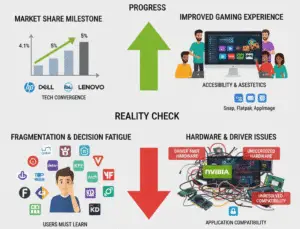
What is EtherChannel? The Superhighway for Your Network Traffic
Imagine your network is like a busy city highway. Single lanes (individual network cables) can get congested, causing traffic jams (network slowdowns). EtherChannel acts like combining multiple lanes into one expressway – it bundles several physical network links into a single logical connection that’s faster, more reliable, and smarter about handling traffic.
EtherChannel Explained: Network Bonding Made Simple
EtherChannel (also called link aggregation) is a networking technique that:
-
Combines 2-8 physical Ethernet links into one logical link
-
Provides higher bandwidth (up to 800Gbps with eight 100Gbps links)
-
Offers automatic failover if one link fails
-
Load-balances traffic across all available links
-
Works with standard Ethernet cables and switches
Key Benefits of EtherChannel




How EtherChannel Works: Real-World Examples
Office Network Scenario:
-
Problem: The connection between your main switch and server is maxed out at 1Gbps
-
Solution: Create a 4-port EtherChannel using four 1Gbps cables
-
Result: Now you have a 4Gbps connection that automatically:
-
Balances traffic across all cables
-
Keeps working if 1-3 cables get unplugged
-
Appears as one simple connection to manage
-
Data Center Use Case:
A cloud provider connects their core switches with:
-
Eight 100Gbps links combined via EtherChannel
-
Creating a virtual 800Gbps backbone
-
Ensuring no single cable failure disrupts service
EtherChannel Protocols: The Traffic Directors
Two main protocols make EtherChannel work:
1. LACP (IEEE 802.3ad)
-
Industry standard protocol
-
Automatically negotiates the bundled link
-
Checks that both ends are properly configured
-
Used by most enterprise networks
2. PAgP (Cisco Proprietary)
-
Cisco’s version of link aggregation
-
Provides additional Cisco-specific features
-
Only works between Cisco devices
Protocol Comparison:
| Feature | LACP | PAgP |
|---|---|---|
| Standard | IEEE 802.3ad | Cisco-only |
| Compatibility | Multi-vendor | Cisco devices only |
| Configuration | Dynamic or static | Dynamic only |
| Common Use | Most enterprises | Cisco shops |
Where EtherChannel Delivers the Most Value
1. Switch-to-Switch Connections
-
Between access and distribution switches
-
In data center spine-leaf architectures
2. Server Connections
-
High-bandwidth links to database servers
-
Virtualization host connections
3. Network Uplinks
-
Connecting to routers or firewalls
-
ISP connections for businesses
4. Bandwidth-Intensive Applications
-
Video production networks
-
Scientific research data transfers
-
Financial trading systems
Setting Up EtherChannel: A Simple Example
Network Setup:
-
Switch A needs more bandwidth to Switch B
-
Four available 1Gbps ports on each switch
Configuration Steps:
-
Designate the ports to bundle on both switches
-
Choose LACP or PAgP protocol
-
Configure load-balancing method
-
Verify the EtherChannel comes up
Sample Cisco Commands:
interface Port-channel1 switchport mode trunk ! interface range GigabitEthernet0/1-4 channel-group 1 mode active switchport mode trunk
EtherChannel vs. Alternatives
| Solution | Speed | Redundancy | Cost | Best For |
|---|---|---|---|---|
| Single Link | 1G/10G/etc | None | $ | Very small networks |
| EtherChannel | 2-8X single | Yes | $$ | Most businesses |
| 10/40/100G | High speed | None | $$$$ | Specialized needs |
Common EtherChannel Mistakes to Avoid




The Future of EtherChannel
Emerging enhancements:
-
Multi-Chassis EtherChannel – Spanning across multiple switches
-
Higher Speeds – Supporting 400G/800G links
-
Cloud Integration – Extending to virtual and hybrid environments
-
AI-Optimized Load Balancing – Smarter traffic distribution
Conclusion: Your Network’s Force Multiplier
EtherChannel transforms your network by:
-
Multiplying available bandwidth without new cables
-
Adding automatic failover protection
-
Simplifying your network topology
-
Providing cost-effective scalability
Whether you’re running a small business network or managing a data center, EtherChannel offers an enterprise-grade solution using standard hardware. It’s like getting a network upgrade without replacing your existing infrastructure.




